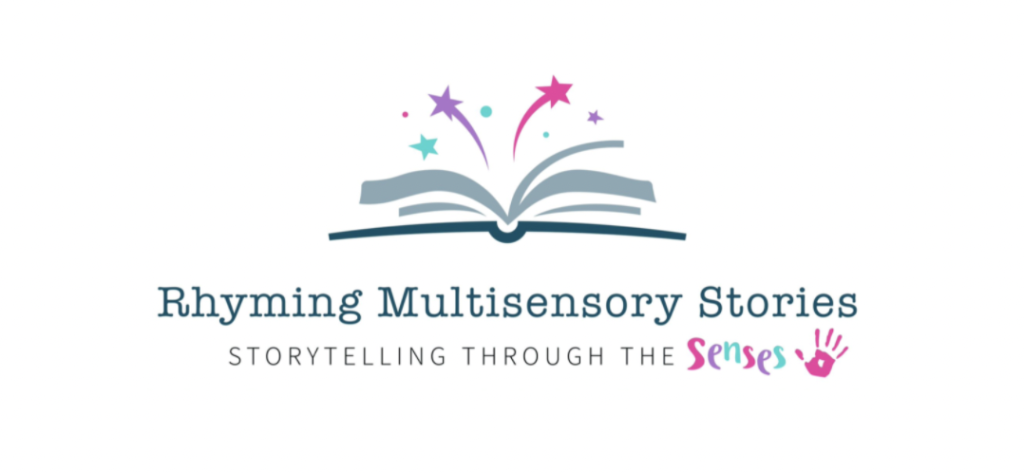I’m often asked what draws me to multisensory storytelling.
There are many benefits to multisensory stories. For me the magic is how the stories can enhance and enrich experiences and create a unique bond between the storyteller and the story explorer as they share their adventures.
Multisensory stories tell a story using props to stimulate the senses and connect individuals to literacy, culture and topic in a fun, meaningful and engaging way
Activities are incorporated into the stories to promote a range of skill development including:
- Communication: building eye contact, listening, shared attention and language development.
- Self-confidence and well-being: empowering people to try out new ideas and skills.
- Practicing self-care and independence and enjoying achievement.
- Building self-awareness, how to communicate a request for ‘help’, ‘again’ and ‘more’.
- Opportunities to explore cause and effect and build anticipation skills.
- Making choices and rejections.
- Promoting physical development, fine and gross motor skills.
- Building knowledge about the environment and the world around us.
- Engaging in scientific experimentation and mathematical concepts, such as routines.
- Supporting social and emotional skills, turn-taking, sharing and teamwork.
I love the flexibility the story props afford and how they provide opportunities for individuals to explore and express their likes, dislikes and sensory preferences in a safe and therapeutic environment, enabling choices and rejections to be made.
Free multisensory stories:
If you would like to have a go at telling a multisensory story, here is a lovely story called ‘The Weather- A Multisensory Exploration.
‘The Dentist,’ is aimed at helping individuals overcome barriers to their oral hygiene. Repeated exposure to the story props in a safe and therapeutic environment builds confidence in preparation for visits out of their daily routine, in this case, an appointment with the dentist.
‘Washing Hands’ promotes independence and self-care, helping individuals overcome barriers to their hand hygiene during the Covid-19 pandemic.
The props are all low budget items found around the home.
Multisensory stories available for a small charge:
Traditional tales such as ‘Jack and the Beanstalk’ can be linked to plants and build fine motor skills by using props for cultivation; soil, bean seeds, light (a ‘torch’), water then explore lifecycles by smelling, touching and tasting different varieties of beans, these can be runner, French, broad, dried beans or tinned beans.
‘The Gingerbread Man’ links to baking, mix flour, sugar, butter to a dough, use pastry cutters to explore shape, add spices (cinnamon, ginger, nutmeg)
‘Holi’, ‘St Patrick’s Day’ and ‘Chinese New Year’ multisensory stories connect the individual to festivals, traditions and places and give you a lot of scope for your props including cultural dress, music, food and religion.
‘Space’, ‘Minibeasts’, and ‘The Beach’ topics promote understanding of the world, materials, living things and the environment and present the opportunity to engage in scientific exploration.
Sourcing Props
When selecting story props, consider the sensory explorer’s needs and abilities and how they interact with objects. This will give you an indication of the texture, weight and shape of a prop to use.
- Be imaginative when choosing your prop. If you are representing an animal, pick its main feature e.g., lion’s mane, tiger’s stripes or a shark’s teeth rather than using a plastic or stuffed toy. You can also use a sound effect.
- Choose props that cover the five main senses, sight, touch, taste, hearing and smell.
- Your props do not need to be costly. Use low budget, everyday items found around the home, garden, outdoors or in the classroom.
- Raid the recycling and up-cycle! Re-use parcel packaging: bubble wrap, corrugated card, foam wrap, polystyrene packing ‘peanuts’, air pillows, foam, shredded paper, Kraft roll and tissue paper.
- Gift bags and pretty boxes are excellent for placing props in to create an air of mystery and for ‘What’s in the Bag/Box?’ activities.
- Plastic containers can be recycled for use as plant pots, paint/glue pots, measuring scoops, sand and water play toys (punch holes through the bottom for an instant waterfall effect) They are versatile for use in craft activities such as junk modelling and making bird feeders. Fill with glitter, confetti, and food dye, (don’t forget to seal!), to make sensory bottles.
- Cardboard boxes become castles, dens, houses, shops, trains, cars, buses, boats, airplanes, rockets, a dolls house, post box, theatre, ice cream van, or a guitar. The imagination is the limit!
- By being creative, you can build up a bank of resources on a very tight budget. Charity shops, jumble sales, garage sales, car boot sales and £1 shops are all good sources of story props.
- Take advantage of the sales e.g., buy Christmas props in the January sales.
Where Shall I Start?
‘The Weather – A Multisensory Exploration’ The weather is a constant in our lives and always changing, and often the clothing and items we used to protect ourselves present unwanted sensory feedback. This story uses the senses to explore the different types of weather and lots of opportunities for individuals to explore their sensory preferences.
Free Resources
Visit the website www.rhymingmultisensorystories.com where you will find sensory ideas and inspiration.
Click on ‘Story Library’ to download your stories.
Choose from:
- The Weather – A Multisensory Exploration
- The Dentist – helping individuals overcome barriers to their oral hygiene
- Washing Hands helping individuals overcome barriers and to understand the importance of hand hygiene in a school setting during the Covid-19 pandemic.
Useful links:
Website: www.rhymingmultisensorystories.com
How to tell a multisensory story
Victoria Navin
Your questions, queries, comments and feedback are always welcome!
Get in touch!
or find me on social media 🙂
